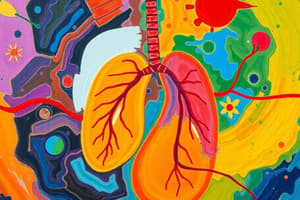Podcast
Questions and Answers
What is the byproduct of lactic acid fermentation in muscle cells during intense, short-duration activities?
What is the byproduct of lactic acid fermentation in muscle cells during intense, short-duration activities?
Lactic acid
What is the ATP yield per glucose molecule during lactic acid fermentation?
What is the ATP yield per glucose molecule during lactic acid fermentation?
2 ATP
What is the common characteristic of lactic acid fermentation and alcoholic fermentation?
What is the common characteristic of lactic acid fermentation and alcoholic fermentation?
Both occur in the absence of oxygen
Where does fermentation occur in organisms?
Where does fermentation occur in organisms?
What is the significance of fermentation in food production?
What is the significance of fermentation in food production?
Why is fermentation less efficient than cellular respiration?
Why is fermentation less efficient than cellular respiration?
Flashcards are hidden until you start studying
Study Notes
Anaerobic Respiration
Lactic Acid Fermentation
- Occurs in muscle cells during intense, short-duration activities
- Glucose is broken down into pyruvate, which is then converted into lactic acid
- No ATP is produced during lactic acid fermentation
- Lactic acid buildup can lead to muscle fatigue and soreness
- Equation: Glucose → 2 Lactic Acid + 2 ATP
- ATP yield: 2 ATP molecules per glucose molecule
Fermentation
- A metabolic process that occurs in the absence of oxygen
- Involves the breakdown of glucose to produce ATP, but does not use the electron transport chain
- Two main types of fermentation: lactic acid fermentation and alcoholic fermentation
- Fermentation occurs in:
- Muscle cells (lactic acid fermentation)
- Yeast cells (alcoholic fermentation)
- Some bacteria
- Fermentation is less efficient than cellular respiration, producing only 2 ATP molecules per glucose molecule
- Fermentation is important for:
- Producing energy in anaerobic environments
- Food production (e.g. bread, beer, wine)
- Industrial applications (e.g. biofuels)
Anaerobic Respiration
Lactic Acid Fermentation
- Muscle cells use lactic acid fermentation during intense, short-duration activities to break down glucose
- Glucose is converted into pyruvate, then into lactic acid, with no ATP produced during this process
- Lactic acid accumulation leads to muscle fatigue and soreness
- The equation for lactic acid fermentation is: Glucose → 2 Lactic Acid + 2 ATP
- Only 2 ATP molecules are produced per glucose molecule in this process
Fermentation
- Fermentation occurs in the absence of oxygen, breaking down glucose to produce ATP without the electron transport chain
- There are two main types of fermentation: lactic acid and alcoholic fermentation
- Fermentation takes place in:
- Muscle cells (lactic acid fermentation)
- Yeast cells (alcoholic fermentation)
- Certain bacteria
- Fermentation is less efficient than cellular respiration, producing only 2 ATP per glucose molecule
- Fermentation is important for:
- Energy production in anaerobic environments
- Food production (e.g., bread, beer, wine)
- Industrial applications (e.g., biofuels)
Studying That Suits You
Use AI to generate personalized quizzes and flashcards to suit your learning preferences.




